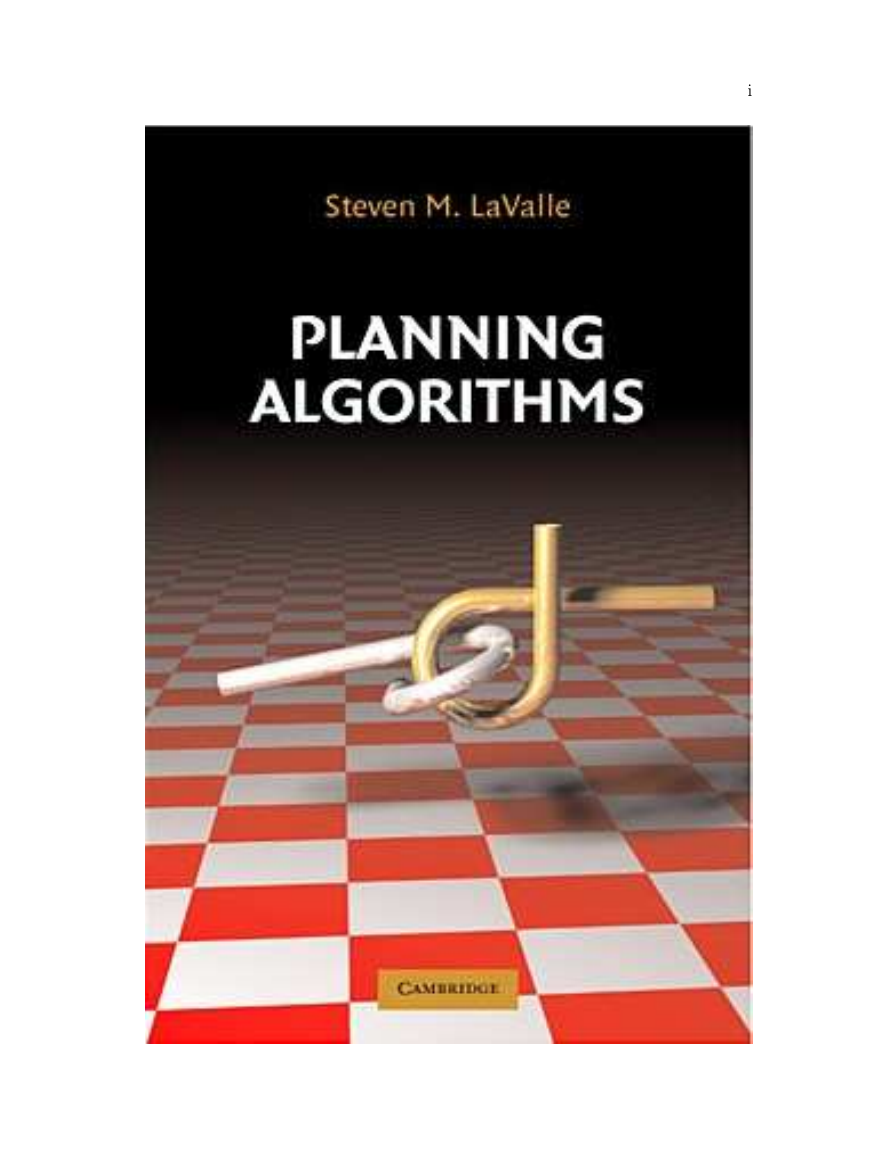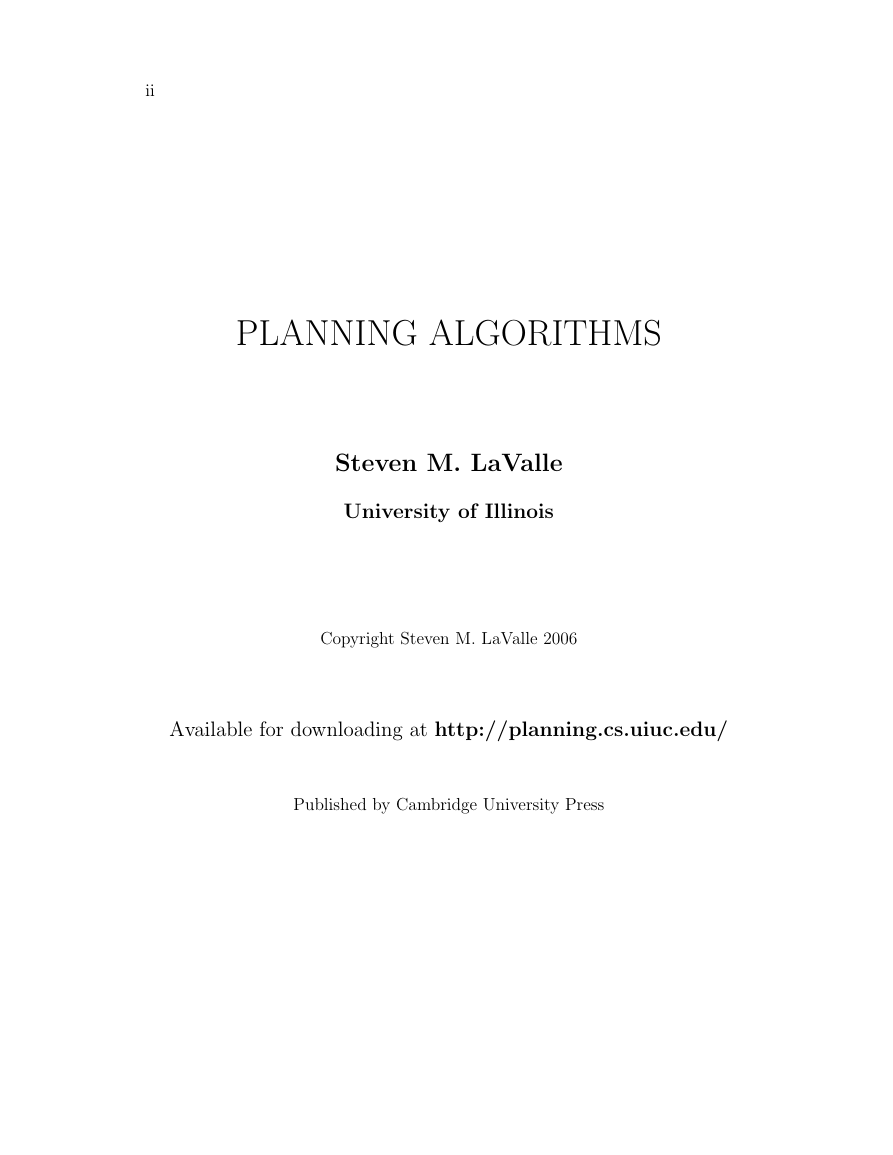Preface
I Introductory Material
Introduction
Planning to Plan
Motivational Examples and Applications
Basic Ingredients of Planning
Algorithms, Planners, and Plans
Organization of the Book
Discrete Planning
Introduction to Discrete Feasible Planning
Searching for Feasible Plans
Discrete Optimal Planning
Using Logic to Formulate Discrete Planning
Logic-Based Planning Methods
II Motion Planning
Geometric Representations and Transformations
Geometric Modeling
Rigid-Body Transformations
Transforming Kinematic Chains of Bodies
Transforming Kinematic Trees
Nonrigid Transformations
The Configuration Space
Basic Topological Concepts
Defining the Configuration Space
Configuration Space Obstacles
Closed Kinematic Chains
Sampling-Based Motion Planning
Distance and Volume in C-Space
Sampling Theory
Collision Detection
Incremental Sampling and Searching
Rapidly Exploring Dense Trees
Roadmap Methods for Multiple Queries
Combinatorial Motion Planning
Introduction
Polygonal Obstacle Regions
Cell Decompositions
Computational Algebraic Geometry
Complexity of Motion Planning
Extensions of Basic Motion Planning
Time-Varying Problems
Multiple Robots
Mixing Discrete and Continuous Spaces
Planning for Closed Kinematic Chains
Folding Problems in Robotics and Biology
Coverage Planning
Optimal Motion Planning
Feedback Motion Planning
Motivation
Discrete State Spaces
Vector Fields and Integral Curves
Complete Methods for Continuous Spaces
Sampling-Based Methods for Continuous Spaces
III Decision-Theoretic Planning
Basic Decision Theory
Preliminary Concepts
A Game Against Nature
Two-Player Zero-Sum Games
Nonzero-Sum Games
Decision Theory Under Scrutiny
Sequential Decision Theory
Introducing Sequential Games Against Nature
Algorithms for Computing Feedback Plans
Infinite-Horizon Problems
Reinforcement Learning
Sequential Game Theory
Continuous State Spaces
Sensors and Information Spaces
Discrete State Spaces
Derived Information Spaces
Examples for Discrete State Spaces
Continuous State Spaces
Examples for Continuous State Spaces
Computing Probabilistic Information States
Information Spaces in Game Theory
Planning Under Sensing Uncertainty
General Methods
Localization
Environment Uncertainty and Mapping
Visibility-Based Pursuit-Evasion
Manipulation Planning with Sensing Uncertainty
IV Planning Under Differential Constraints
Differential Models
Velocity Constraints on the Configuration Space
Phase Space Representation of Dynamical Systems
Basic Newton-Euler Mechanics
Advanced Mechanics Concepts
Multiple Decision Makers
Sampling-Based Planning Under Differential Constraints
Introduction
Reachability and Completeness
Sampling-Based Motion Planning Revisited
Incremental Sampling and Searching Methods
Feedback Planning Under Differential Constraints
Decoupled Planning Approaches
Gradient-Based Trajectory Optimization
System Theory and Analytical Techniques
Basic System Properties
Continuous-Time Dynamic Programming
Optimal Paths for Some Wheeled Vehicles
Nonholonomic System Theory
Steering Methods for Nonholonomic Systems
















 2023年江西萍乡中考道德与法治真题及答案.doc
2023年江西萍乡中考道德与法治真题及答案.doc 2012年重庆南川中考生物真题及答案.doc
2012年重庆南川中考生物真题及答案.doc 2013年江西师范大学地理学综合及文艺理论基础考研真题.doc
2013年江西师范大学地理学综合及文艺理论基础考研真题.doc 2020年四川甘孜小升初语文真题及答案I卷.doc
2020年四川甘孜小升初语文真题及答案I卷.doc 2020年注册岩土工程师专业基础考试真题及答案.doc
2020年注册岩土工程师专业基础考试真题及答案.doc 2023-2024学年福建省厦门市九年级上学期数学月考试题及答案.doc
2023-2024学年福建省厦门市九年级上学期数学月考试题及答案.doc 2021-2022学年辽宁省沈阳市大东区九年级上学期语文期末试题及答案.doc
2021-2022学年辽宁省沈阳市大东区九年级上学期语文期末试题及答案.doc 2022-2023学年北京东城区初三第一学期物理期末试卷及答案.doc
2022-2023学年北京东城区初三第一学期物理期末试卷及答案.doc 2018上半年江西教师资格初中地理学科知识与教学能力真题及答案.doc
2018上半年江西教师资格初中地理学科知识与教学能力真题及答案.doc 2012年河北国家公务员申论考试真题及答案-省级.doc
2012年河北国家公务员申论考试真题及答案-省级.doc 2020-2021学年江苏省扬州市江都区邵樊片九年级上学期数学第一次质量检测试题及答案.doc
2020-2021学年江苏省扬州市江都区邵樊片九年级上学期数学第一次质量检测试题及答案.doc 2022下半年黑龙江教师资格证中学综合素质真题及答案.doc
2022下半年黑龙江教师资格证中学综合素质真题及答案.doc